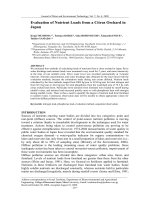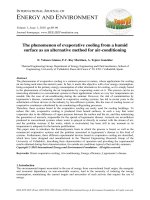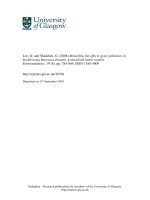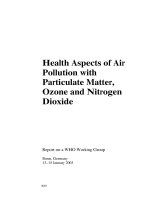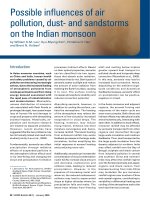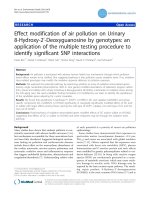MEASUREMENTS OF AIR POLLUTION FROM A DANISH HIGHWAY pot
Bạn đang xem bản rút gọn của tài liệu. Xem và tải ngay bản đầy đủ của tài liệu tại đây (2.55 MB, 47 trang )
AU
NATIONAL ENVIRONMENTAL RESEARCH INSTITUTE
AARHUS UNIVERSITY
Research Notes from NERI No. 254 2009
MEASUREMENTS OF AIR POLLUTION
FROM A DANISH HIGHWAY
[Blank page]
NATIONAL ENVIRONMENTAL RESEARCH INSTITUTE
AARHUS UNIVERSITY
AU
Research Notes from NERI No. 254 2009
MEASUREMENTS OF AIR POLLUTION
FROM A DANISH HIGHWAY
Thomas Ellermann
Steen Solvang Jensen
Matthias Ketzel
Per Løfstrøm
Andreas Massling
[Blank page]
'DWDVKHHW
Series title and no.: Research Notes from NERI No. 254
Title: Measurements of air pollution from a Danish highway
Author(s): Thomas Ellermann, Steen Solvang Jensen, Matthias Ketzel, Per Løfstrøm and Andreas
Massling
Department(s): Department of Atmospheric Environment
Publisher: National Environmental Research Institute
University of Aarhus - Denmark
URL:
Year of publication: July 2009
Referee(s): Martin Hvidberg
Financial support: The Danish Road Directorate. Ministry of Transport
Please cite as: Ellermann, T., Jensen, S.S., Ketzel, M., Løfstrøm, P. & Massling, A. 2009: Measurements of air
pollution from a Danish highway. National Environmental Research Institute, Aarhus University.
43pp. - Research Note from NERI 254. />
Reproduction permitted provided the source is explicitly acknowledged
Abstract: This report presents the results from a measurement campaign carried out at the Holbæk High-
way during 2008. The objective of the campaign was to determine the emission factors for PM
2.5
and PM
10
due to highway traffic. The campaign included measurements of NO
x
, NO, NO
2
,
TEOM PM
2.5
, TEOM PM
10
, O
3
, particle size distribution and local meteorology. The emission
factors for PM
2.5
and PM
10
were determined to 45 and 155 mg/(vehicle km), respectively. This is
comparable to the emission factors previously determined for H. C. Andersens Boulevard in
Copenhagen and somewhat higher than found at Jagtvej, Copenhagen.
Keywords: Emission factors, PM
10
, PM
2.5
, highway traffic, measurement campaign. NO
x
, NO
2
, NO, meteor-
logical measurements, particle size distribution.
Layout: Majbritt Ulrich
ISSN (electronic): 1399-9346
Number of pages: 43
Internet version: The report is available in electronic format (pdf) at NERI's website
/>
&RQWHQWV
3UHIDFH
6XPPDU\
6DPPHQIDWQLQJ
,QWURGXFWLRQ
0HDVXUHPHQW&DPSDLJQ
2.1 Selection of measurement sites 11
2.2 Measurement stations, methods, quality assurance and data storage 13
2.3 Traffic at the measurement site 16
0HWHRURORJ\
1LWURJHQ2[LGHV12
2]RQH2
3
30 DQG30 7(20
3DUWLFOHQXPEHUYROXPHDQGQXPEHUVL]HGLVWULEXWLRQ
(PLVVLRQIDFWRUVIRU30 DQG30
5HIHUHQFHV
1DWLRQDO(QYLURQPHQWDO5HVHDUFK,QVWLWXWH
5HVHDUFK1RWHVIURP1(5,
4
3UHIDFH
This report was prepared as part of a cooperative project with the Danish
Road Directorate on development of a GIS based version of the Danish
air quality model OML-Highway, which is going to be used as a tool for
estimation of air pollution of nitrogen oxides and particles (PM
10
and
PM
2.5
) from Danish highways. This new project was a follow up on a
previous project were the specifications for the GIS based version of
OML-Highway were made.
The model calculations using OML-Highway are among others based on
input of emission factors for nitrogen oxide (NO
x
) and particle mass
(PM
10
and PM
2.5
) for highway traffic. However, the emission factors for
particle mass are uncertain and at present only few measurements of the
emission factors for particle mass from highway traffic have been carried
out. Therefore a measurement campaign with focus on direct measure-
ment of emission factors of PM
2.5
and PM
10
from Danish highway traffic
was included as part of the project. This report describes the measure-
ment campaign and the results from the campaign.
The project was funded by the Danish Road Directorate.
Bjarne Jensen, Tom Rasmussen, Hans Nielsen, Morten Hildan, Henrik
W. Madsen, Jane Søfting, Keld Mortensen and Axel Egeløv are acknowl-
edged for their technical work and their valuable contributions to the
project.
5
6XPPDU\
This report summarises the results from a measurement campaign at the
Holbæk Highway during March and April 2008. The aim of the meas-
urement campaign was to determine the emission factors for PM
2.5
and
PM
10
from highway traffic. The project was carried out in cooperation
with the Danish Road Directorate which also financed the project.
During the campaign one measurement station was placed directly at the
north side of the highway and one measurement station was placed
about 150 m south of the highway. In this way it was possible to deter-
mine the air pollution from the highway traffic during periods with
southerly wind direction. The measurements included NO
x
, NO, NO
2
,
O
3
, PM
2.5
(TEOM), PM
10
(TEOM) and particle size distribution. More-
over, the meteorological conditions were also measured at the back-
ground station.
The concentrations of NO
x
, NO, and NO
2
at the highway station (Station
1) were at the same levels as measured at H. C. Andersens Boulevard in
Copenhagen during the same time period. The levels measured at the
background station (Station 2) were similar to the levels at the urban
background station in Copenhagen (H.C. Ørsteds Institute, Copenha-
gen). Moreover, the results showed that more than 75% of NO
x
, NO, and
NO
2
at the highway station came directly from the highway traffic.
The concentrations of PM
2.5
at the highway station (Station 1) were com-
parable to the levels measured at the urban background station in Co-
penhagen (H.C. Ørsteds Institute, Copenhagen). The levels measured at
the background station (Station 2) were comparable to the levels meas-
ured at the rural background station at Lille Valby.
When the results for PM
2.5
and PM
10
are corrected for loss of volatile par-
ticle mass, then the particle mass of PM
2.5
and PM
10
at the highway sta-
tion originating from the highway traffic were estimated to about 10%
and 45%, respectively. This is in agreement with other studies, which
have shown that the long range transported fraction of the particle mass
is relatively high. Consequently, the fraction of PM
2.5
and PM
10
originat-
ing from the highway traffic is low.
The measurements of the particle size distribution showed, that the
highway traffic is a quite strong source of ultrafine particles with diame-
ters below 100 nm. For the entire measurement campaign the average
particle number per cm
3
was a factor of four higher at the highway sta-
tion compared to the background station. The number size distribution
showed that it was mainly the smallest particles (10 -50 nm) which came
from the highway traffic. However, the highway traffic contributed also
significantly to the particles in the range 50 – 150 nm typical for soot.
6
The average emission factors for PM
2.5
and PM
10
were calculated to 45
and 155 mg/(vehicle km), respectively. This is similar to the emission
factors previously determined for H. C. Andersens Boulevard in Copen-
hagen and somewhat higher than found at Jagtvej, Copenhagen. This in-
dicates that the high velocity at the highway do not have a strong influ-
ence on the emissions of particles.
7
6DPPHQIDWQLQJ
Denne rapport sammenfatter resultaterne fra målinger udført i forbin-
delse med en målekampagne ved Holbæk Motorvejen i perioden marts
til april 2008. Målet med kampagnen var at bestemme emissionsfakto-
rerne for PM
2.5
og PM
10
fra motorvejstrafik. Projektet blev udført i sam-
arbejde med Vejdirektoratet, som ligeledes finansierede arbejdet.
I forbindelse med målekampagnen blev der opstillet en målestation di-
rekte på nordsiden af motorvejen (Station 1) og en baggrundsmålestation
omkring 150 m syd for motorvejen (Station 2). Hermed er det muligt at
bestemme luftforureningen fra motorvejstrafikken når vinden blæser fra
sydlig retning. Målingerne inkluderede NO
x
, NO, NO
2
, O
3
, TEOM PM
2.5
,
TEOM PM
10
og partikelstørrelsesfordeling. De meteorologiske forhold
blev ligeledes målt ved baggrundsmålestationen (Station 2).
Koncentrationerne af NO
x
, NO, og NO
2
ved motorvejsstationen (Station
1) var på niveau med niveauerne målt på H. C. Andersens Boulevard,
København for den samme tidsperiode. Niveauerne målt på bag-
grundsmålestationen (Station 2) svarede til niveauerne målt på bybag-
grundsmålestationen (H. C. Ørsteds Institutet, København). Mere end
75% af NO
x
, NO og NO
2
ved motorvejsmålestationen (Station 1) kom di-
rekte fra motorvejstrafikken.
Koncentrationerne af PM
2.5
ved motorvejsmålestationen (Station 1) sva-
rede til niveauerne målt på bybaggrundsmålestationen (H. C. Ørsteds
Institutet, København). Niveauerne målt på baggrundsmålestationen
(Station 2) svarede til niveauerne målt på landbaggrundsmålestationen
ved Lille Valby.
Når resultaterne for PM
2.5
og PM
10
blev korrigeret for tab af partikelmas-
se i TEOM-instrumenterne var andelen af partikelmassen, som kom fra
motorvejstrafikken, henholdsvis omkring 10% og 45%. Dette er i over-
ensstemmelse med resultater fra andre studier, som har vist, at en relativ
stor del af partikelmassen generelt er langtransporteret. Dermed bliver
bidraget fra motorvejstrafikken relativ lille.
Målinger af partikelstørrelsesfordelingen viste, at motorvejstrafikken er
en betydelig kilde til ultrafine partikler med diameter under 100 nm.
Som gennemsnit for hele måleperioden var det gennemsnitlige partikel-
antal fire gange højere ved motorvejsmålestationen (Station 1) end ved
baggrundsmålestationen (Station 2). Partikelstørrelsesfordelingen viste,
at det navnlig var de mindste partikler (10 – 50 nm), som kommer fra
motorvejstrafikken. Dog bidrager motorvejstrafikken også betydeligt til
partikler i størrelsesorden fra 50-150 nm, som er typisk for sodpartikler-
ne.
Emissionsfaktorerne for PM
2.5
og PM
10
blev beregnet til henholdsvis 45
og 155 mg/(køretøjs km). Det svarer til det der tidligere er blevet målt
for H. C. Andersens Boulevard i København. Emissionsfaktorerne målt
for Jagtvej, København er lidt mindre end målt ved motorvejen. Dette vi-
ser, at den høje hastighed på motorvejen tilsyneladende ikke spiller en
stor rolle for mængden af partikler udledt fra trafik.
8
,QWURGXFWLRQ
In recent decades the traffic intensity on the Danish highways has in-
creased significantly and there is therefore a need for a tool, which can
be used to estimate the air pollution of nitrogen dioxide (NO
2
) and parti-
cles (PM
2.5
and PM
10
) from highway traffic. On this background NERI
carried out a cooperative project in 2005-2006 together with and funded
by the Danish Road Directorate. This first project was the first step
(phase 1) towards development of a GIS-based version of NERI’s air
quality model OML-Highway. In phase 1 the overall specifications for
the GIS based version of OML-Highway were made. The results from
this project are reported in Berkowicz et al., (2007).
In 2007 the Danish Road Directorate funded phase 2 with the objective to
make the operative GIS-based version of OML-Highway. As part of this
project model calculations for two examples was carried out in order to
demonstrate the abilities of the GIS-based version.
One of the conclusions from phase 1 was that the emission factors for
particle mass emitted due to highway traffic are very uncertain (Berko-
wicz et al., 2007), because the emission of particles not only originates
from exhaust but also from dust from road, wear of tires and brakes, and
from salting of the highway during winter time. The effective emission
factors for particles have until now only been measured in Danish cities,
where the emissions of particles may be different from emissions due to
highway traffic. To overcome this problem phase 2 included a measure-
ment campaign with the objective to measure the effective emission fac-
tor for PM
2.5
and PM
10
for Danish highway traffic.
This measurement campaign was carried out during April and March
2008 at a site on the Holbæk Highway (route No. 21) north of Tåstrup.
This report describes the measurement campaign, the used methods and
present the results from the campaign.
9
0HDVXUHPHQW&DPSDLJQ
The measurement campaign took place during the period from 08-03-
2008 to 07-05-2008. The strategy behind the measurement campaign was
to measure the particle mass (PM
2.5
and PM
10
) and the concentrations of
NO
x
simultaneously at two measurement sites close to a Danish high-
way. In this way we could isolate the contribution from the highway
traffic and determine the emission factors for PM
2.5
and PM
10
relative to
the emission factor for NO
x
(see explanation below).
During the campaign one measurement site (Station 1) was placed di-
rectly at the northern side of the highway which most often is the
downwind side of the highway (Figure 2.1). The other measurement site
(Station 2) was placed 250 m southwest from Station 1 and about 150 m
south of the highway. Station 2 is most often on the upwind side of the
highway. During southerly wind subtraction of the results from the two
sites can be used to calculate the concentrations resulting from the high-
way traffic alone. This requires that no other local sources are present
within the measurement area. This strategy has been used with success
in a series of other studies and is also one of the main principles behind
the selection of measurement sites in the Danish Air Quality Monitoring
Programme (Kemp et al., 2008).
The two white measurement containers at the measurement site. One station
was placed at the northern side and the other station was placed about 150 m south of
the highway. The picture is taken from the bridge at Bondehøjvej.
10
The emission factor for PM can be determined relative to the emission
factor for NO
x
. This is based on the simple assumption, that both PM and
NO
x
are diluted in the same way. Based on this assumption the ratio be-
tween the concentration of PM and the emission factor of PM is equal to
the ratio between the concentration of NO
x
and the emission factor of
NO
x
:
(&(30 // =
where E
PM
and E
NOx
are emission factors for particles and NO
x
, respec-
tively. PM is the particle mass measured either as PM
2.5
or PM
10
, and
C
NOx
is the concentration of NO
x
. PM and C
NOx
are the concentrations re-
sulting from the highway traffic (Station 1 minus Station 2) for southerly
winds. This can be rearranged to:
)/( &30(( =
The total emission factor for NO
x
from traffic are well known (e.g. the
European COPERT 4; EEA 2007) and depend only on traffic intensity,
composition of traffic and speed of traffic. Hence the total emission fac-
tor for PM
10
and PM
2.5
can be calculated.
This method has previously been used by Ketzel and coworkers to de-
termine the emission factors for particle mass at busy streets in Copen-
hagen (Ketzel et al., 2007).
The applied NO
x
emission factors have been validated in a previous
measurement and model project for Danish highway conditions (Jensen
et al., 2004).
The particle mass is measured with a TEOM instrument that has a
known artefact. Due to the measurement principle part of the particle
mass evaporates, because the particles are heated to 50 ºC during the
measurements. Measurements have shown that the loss is the same at
kerb site and urban background (Palmgren et al., 2003). It is therefore
mainly the non local particle mass that evaporates. This means, that the
PM measurements at both Station 1 and 2 will be affected equally since
the particle mass due to non local sources are equal at the two stations.
Evaporation of part of the particle mass is off course a disadvantage with
the TEOM instruments. However, at present it is the only instrument
that can measure particle mass with high time resolution (½ hour), and
this is needed in this measurement campaign. Calculation of the contri-
butions to particle mass due to the highway traffic can only be done with
high time resolution due to frequent changes in wind direction during a
day.
The measurements of particle mass and nitrogen oxides were supple-
mented with measurements of ozone and particle size distribution for
the fine particles (range from 10 nm up to 700 nm).
11
6HOHFWLRQRIPHDVXUHPHQWVLWHV
There was a series of criteria for selection of the measurement sites:
1. High traffic density in order to ensure that the air pollution due to
the highway traffic was relatively high compared to the background
air pollution.
2. Few other local sources than the highway traffic.
3. The direction of the highway should preferable be east-west due to
high frequency of wind from southerly directions.
4. Sufficient power supply.
5. Possibility and permission to position the measurement station at the
site of the highway.
6. Easy access to the measurement sites and not too far from NERI.
7. Availability of traffic information.
8. Representative traffic composition.
9. Representative diurnal traffic pattern.
10. Simple terrain.
Based on inspection of maps and aerial photos a number of possible
measurement sites were selected. After a visit to these sites it was de-
cided, that the best site for the measurement campaign was at Highway
21 where Bondehøjvej via a bridge crosses the highway north of Taas-
trup (Figure 2.2 and 2.3). The Danish Road Directorate measures the traf-
fic flow and speed at this site (measurement station No. 41). Criteria 1-9
were fulfilled here. The only disadvantages were with respect to criteria
10.
The terrain (criteria 10) is quite complex due to the high trees and the
slopes down to the highway (Figure 2.1). This would not give direct
problems for the measurement of the emission factor for particle mass.
The only problem will be during comparisons of measurements and
model results, because the model may not be able to give good results
due to this quite complex terrain.
12
The black box shows the site for the measurement campaign.
Aerial view of the measurement site. The red dots indicate the position of the
two measurement stations (Station 1 and 2) and the blue dot indicates the position of the
meteorological mast. Source: Google Earth.
The highway curves slightly at the measurement site. This has to be
taken into account when the wind directions usable for determination of
the air pollution due to the highway traffic is selected. Figure 2.4 show
that at directions between 85º and 245º the air mass arriving at the back-
ground measurement station (Station 2) will in principle not be affected
by air pollution from the highway. However, due to short term fluctua-
tions of the wind directions it is necessary to reduce the usable wind di-
13
rections. It is therefore estimated, that the measurements at Station 2 will
not be affected by air pollution from the highway at wind directions
from 105º-225º at low wind speeds and 95º-235º at strong wind speeds.
The numbers on the map illustrates the wind directions (degrees) where the
measurements at Station 2 will not be affected by air pollution due to the highway traffic.
At strong wind speeds this is between 105º-225º and at low wind speeds this is between
95º-235º.
0HDVXUHPHQWVWDWLRQVPHWKRGVTXDOLW\DVVXUDQFH
DQGGDWDVWRUDJH
The two NERI mobile measurement stations and the meteorological mast
can be seen in Figure 2.5 and 2.6. The GPS positions are listed in Table
2.1.
The measurement instruments used during the campaigns are listed in
Table 2.2. For NO
x
and O
3
NERI’s accredited methods and quality control
procedures were followed. The methods used for TEOM (Tapered-
element Oscillating Microbalance) and DMPS (Differential Mobility Par-
ticle Sizer) followed standard procedures described by the manufacturer.
The meteorological measurements using a SONIC anemometer (10 Hz
acoustic measurements in three dimensions of temperature, wind speed
and direction) followed standard procedures described by the manufac-
turer.
Position of Station 1, Station 2 and the meteorological mast. UTM 32 is with datum WGS84.
Meteorological mast: UTM 32 E UTM 32 N Længde Bredde
Station 1 Highway 327248 6172272.5 12° 15 min. 12 sec. 55° 39 min. 56 sec.
Station 2 Background 327125 6172066.5 12° 15 min. 6 sec. 55° 39 min. 49 sec.
Meteorlogical mast 327104 6172062 12° 15 min. 5 sec. 55° 39 min. 49 sec.
14
The data from the instruments were send by modem to NERI and stored
in NERI’s databases. Near real time data from the measurement cam-
paign were available via NERI’s intranet. This ensured a fast preliminary
quality control of the measurements. This improved the running time for
the instruments and the quality of the data.
Moreover, parallel measurements in the laboratory with the two TEOM
instruments and the two DMPS instruments were carried out prior and
after the measurement campaign. This ensured that systematic errors be-
tween the measurements at Station 1 and 2 were as small as possible.
The NERI measurement station at Station 1 at the northern side of the high-
way. The mast and metal box in front of the picture is the Danish Road Directorate’s traf-
fic measurement station No. 41.
15
The NERI measurement station and the meteorological mast at Station 2 at
the background position about 150 m south of the highway.
Instruments used during the measurement campaign.
NO
x
, NO, NO
2
X X API Chemiluminescent NOx
Analyzer, Model 200A
½ hour 3.1 m ±10%+3 ppb
O
3
X API Photometric O
3
Analyzer,
Model 400A
½ hour 3.1 m ±10%+3 ppb
PM
2.5
(TEOM) X X Rupprecht & Patashnick Co.,
Inc., TEOM Particulate Mass
Monitor Series 1400
½ hour 3.8 m ±1 µg/m
3
PM
10
(TEOM) X X Rupprecht & Patashnick Co.,
Inc., TEOM Particulate Mass
Monitor Series 1400
½ hour 3.7 m ±1 µg/m
3
DMPS X X Home build ½ hour 3.4 m
Sonic Ane-
mometer
X Model USA-1 from METEK
GmbH
10 Hz / ½ hour 7.2 m
16
7UDIILFDWWKHPHDVXUHPHQWVLWH
The Danish Road Directorate has delivered traffic data. Traffic data
consist of data from an automatic traffic counting station and from short
counts (manual counts) (Danish Road Directorate 2006). The traffic data
are used to calculate emissions with the emission module of the
WinOSPM. It is necessary to estimate the Average Daily Traffic (ADT),
the vehicle distribution, speed, the diurnal variation, and traffic data as a
time-series. ADT for the six lane highway was 58,291 in 2007.
$XWRPDWLFWUDIILFFRXQWV
Automatic traffic counts have been obtained from a permanent traffic
count station as part of the so-called TRIM traffic monitoring system in
Greater Copenhagen. The automatic traffic count station is located right
next to the location of the air quality measurement equipment (Figure
2.5). Data are available for the full period of the air quality measurement
campaign.
The traffic data include the number of vehicles and average speed in 15
minutes intervals subdivided in three vehicle length categories (0m -
5.80m, 5.80m - 12.50m, 12.50m -). The length is the length between axles
of the vehicle. Data are available for each of the three lanes in each
direction of the motorway.
In principle it should be possible to use the automatic traffic counts to
estimate the vehicle distribution. However, there are limitations as the
vehicle length 0m - 5.8m includes passenger cars and vans and even
small trucks. Analysis of similar data has shown that automatic traffic
data are not suitable for estimation of the detailed vehicle distribution
needed for emission estimation. Therefore, the automatic traffic counts
are only used to estimate Average Daily Traffic (ADT) and the diurnal
variation on hourly basis. The average diurnal variation is described for
Mondays to Thursdays, Fridays, Saturdays, and Sundays. This
subdivision takes into account the differences in diurnal variation
between different days of the week. A complete time-series (hour by
hour) will also be generated for model calculations.
Former analysis has also revealed that it is not necessary to handle each
lane separately but just each direction (three lanes together) to obtain
good agreement between modelled concentrations at different distances
from the motorway. Therefore, data are aggregated on a direction by
direction basis.
The emission module of the WinOSPM model is used to generate
emissions based on hourly means of traffic data.
0DQXDOWUDIILFFRXQWV
Manual traffic counts are only carried out at selected locations. Manual
counts provide detailed information about the vehicle categories and the
diurnal variation. Manual counts are carried out for one day hour by
hour during 6:00 am to 6:00 pm. The vehicle categories counted are: pas-
senger cars, vans, truck(>3,5t), truck with trailer, semi-trailer, busses, and
motorcycles. Counts are carried out for each direction separately.
17
The locations that are closest to the location of the air quality measure-
ment site have been chosen to represent the vehicle distribution at the
site. Two manual traffic count sites were identified (Table 2.3). The loca-
tions of the two manual traffic counts are shown in Figure 2.7.
The two manual traffic count sites.
11-17/811 Holbæk motorway north of Vallensbæk
Mose
March 20, 2007
11-17/811 Holbæk motorway north of Vallensbæk
Mose
Sept. 9, 2007
11-47/106 Holbæk motorway at Kirke Såby East of
Roskilde
March 20, 2007
11-47/106 Holbæk motorway at Kirke Såby East of
Roskilde
Sept. 5, 2007
11-47/106 Holbæk motorway at Kirke Såby East of
Roskilde
April 3, 2008
18
Locations of the two manual traffic count sites. Top: Overview. Middle and bot-
tom: The two stations at higher spatial resolution.
19
0HWHRURORJ\
The meteorological measurements were primarily established to deter-
mine wind direction in order to be able to select situations where the air
pollution measurements at the background station (Station 2) were not
affected by the highway emissions. Secondly, data were used to demon-
strate that the local meteorological conditions were not abnormal.
Thirdly, data will be used for detailed analysis of the air pollution meas-
urements and will be processed for possible OML-Highway model calcu-
lations. The meteorological instrument and the position are described in
Chapter 2.
The 10 Hz sonic measurements have been averaged to 10 minutes values.
In Figure 3.1 the wind directions for the entire campaign are shown. The
read dashed lines marks the wind direction sector where the highway
emissions are not expected to have impacts on the measurements of the
background concentration.
Wind speed and temperature are shown in Figure 3.2 and 3.3. Precipita-
tion at Lille Valby 9 km to the west-north-west of the highway is pre-
sented in Figure 3.4.
0
45
90
135
180
225
270
315
360
07-03-08 14-03-08 21-03-08 28-03-08 04-04-08 11-04-08 18-04-08 25-04-08 02-05-08 09-05-08
Wind directions during the campaign (10 min. averages). The red dashed lines mark the wind direction sector (105-
225°) where the highway emissions have no impact on the background concentration.
20
One step in checking and preparing the meteorological data is to correct
the raw sonic measurement for tilt (apparently non-horizontal mean
flow). Tilt can be due to non-ideal circumstances in the physical place-
ment of the mast and instrument, the terrain inclination and the minor
flow distortion around the sonic. The correction is not vital for the pa-
rameters already shown, but for the turbulence parameters accounting
for the dilution of air pollution the correction is essential. The tilts are
0
2
4
6
8
10
12
07-03-08 14-03-08 21-03-08 28-03-08 04-04-08 11-04-08 18-04-08 25-04-08 02-05-08 09-05-08
Wind speed during the campaign (10 min. averages).
-10
-5
0
5
10
15
20
07-03-08 14-03-08 21-03-08 28-03-08 04-04-08 11-04-08 18-04-08 25-04-08 02-05-08 09-05-08
Temperature (10 min. averages).
0
10
20
30
40
50
60
70
07-03-08 14-03-08 21-03-08 28-03-08 04-04-08 11-04-08 18-04-08 25-04-08 02-05-08 09-05-08
Accumulated precipitation measured at Lille Valby 9 km to the west-north-west of the highway. Data measured by
Risø DTU.
21
shown in Figure 3.5. Here the approximately sinusoidal ‘mean’-shape is
due to the combined tilt of the mast/sonic and the ground. The offset of
about 1 degree is due to flow distortion around the sonic.
The main turbulence parameters accounting for the dilution of air pollu-
tion have been calculated and are shown in the next figures. Figure 3.6
shows the time variation of the friction velocity (u
*
). It is a parameter de-
scribing the mechanical turbulence generated due to the friction from the
surface. In Figure 3.7 is shown the sensible heat flux from the ground to
the atmosphere. It is a measure for the so-called thermic turbulence.
The aerodynamic roughness length, z0, is a parameter describing the
roughness of the ground in the surroundings. It is calculated for each 10
minutes period and is primarily based on the friction velocity. In Figure
3.8 z0 is shown as a function of the wind directions. The tall trees at the
highway in the northerly sector give rise to the relative high values of z0.
Over all, the meteorological measurements seem to behave as expected
for the weather conditions during the campaign confirming that the
quality of the results are acceptable.
-15
-10
-5
0
5
10
15
0 45 90 135 180 225 270 315 360
The tilt of the flow relative to the sonic (10 min. averages).
22
0
0.2
0.4
0.6
0.8
1
1.2
1.4
07-03-08 14-03-08 21-03-08 28-03-08 04-04-08 11-04-08 18-04-08 25-04-08 02-05-08 09-05-08
Friction velocity is a measure of mechanical turbulence.
-100
-50
0
50
100
150
200
250
300
350
07-03-08 14-03-08 21-03-08 28-03-08 04-04-08 11-04-08 18-04-08 25-04-08 02-05-08 09-05-08
Sensible heat flux from ground to atmosphere (positive) responsible for generation of thermic turbulence.
0.0
0.1
0.2
0.3
0.4
0.5
0.6
0.7
0.8
0.9
1.0
0 30 60 90 120 150 180 210 240 270 300 330 360
Aerodynamic roughness lengths, z0. The red dashed lines marks the wind direction sector where the highway emis-
sions have no impact on the background concentration. The values above 0.05 m are due to vegetation (trees and bushes) in
the surroundings at about 150 m distance.
